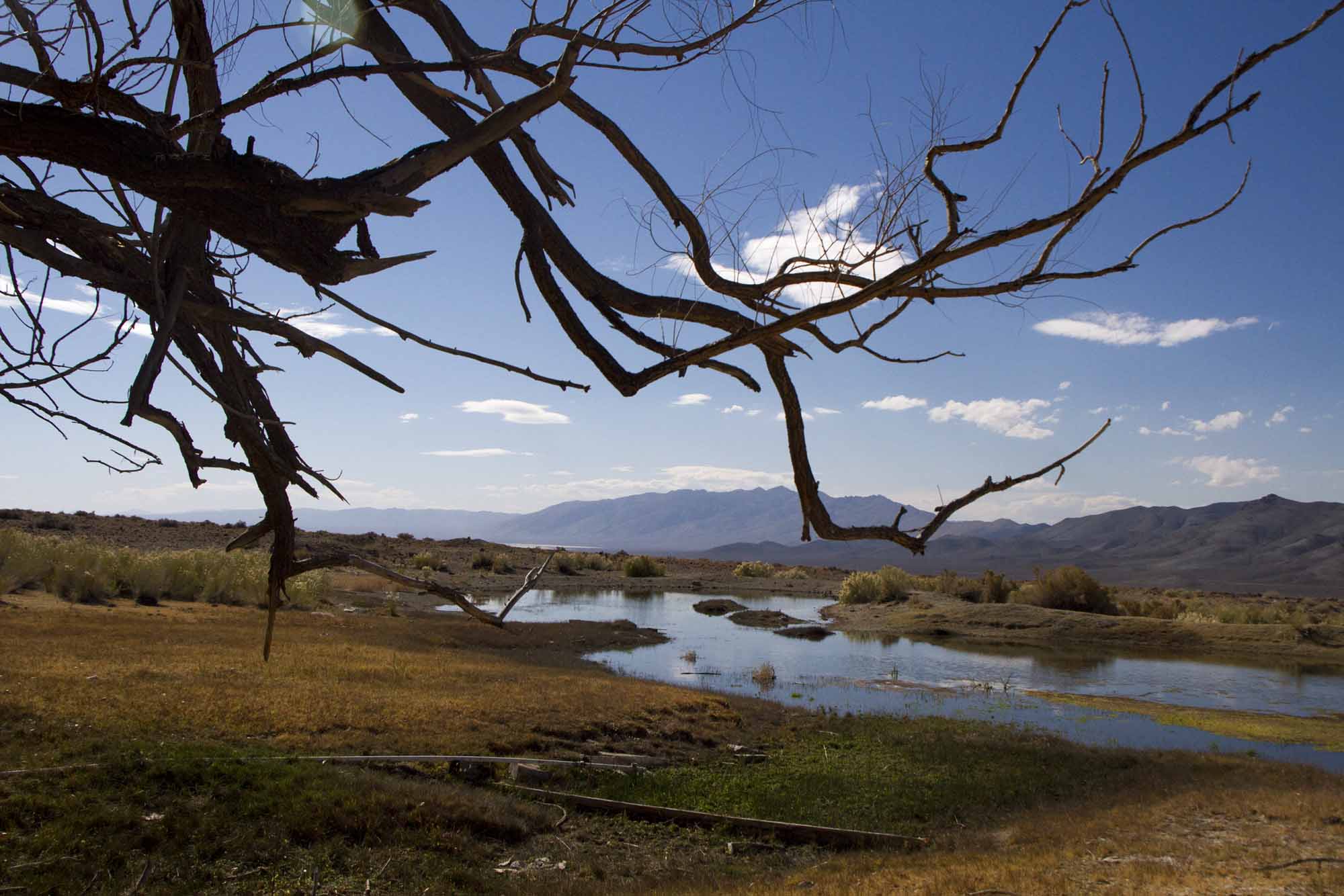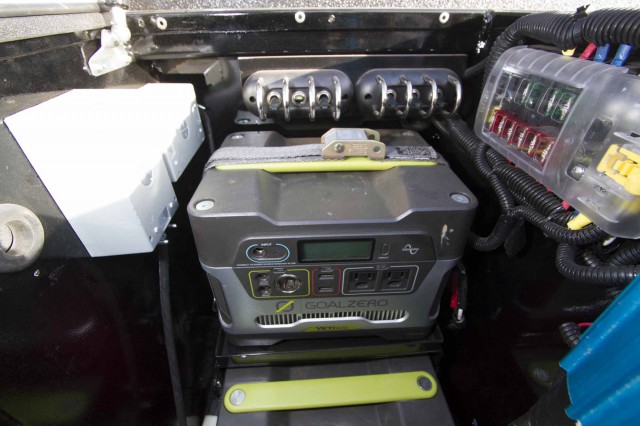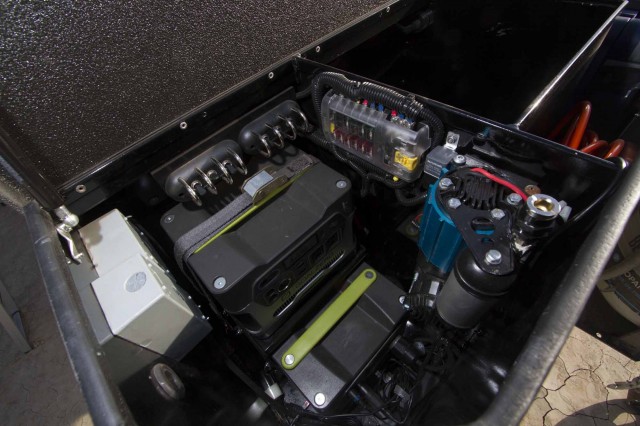A kaleidoscopic pallet of citrus orange, inferno red, and vermilion washed the Northern Nevada sky as the sun began its debut over the Western deserts. I crawled down from my roof top tent, set the coffee, and got the fire going. The clouds appeared to be aflame as the first rays partitioned them from the inky mountains below. Like my dad, I’m an early riser. My internal clock launches my mind into cognizance in the wee hours; witnessing the sunrise and taking in the rich aroma of coffee drifting through camp are the payoffs. My dad crawled out of his tent to a hot cup o’ joe and Bailey’s, and we discussed plans for the day’s ride. We were smack dab in the middle of Adobe Flat, an anvil-flat dry lake about 10 miles in breadth. Some distance to the west was the end-of-the-road Wild West town of Gerlach and the famed Black Rock Desert. A few mountain ranges to the east was the town of Lovelock, a previous way station for settlers en route to California on the Humboldt Trail. My dad, an old dirt dog who raced a Greeves 250 in the first Barstow to Vegas in 1967, had just celebrated his 78th birthday. We’d thought it fitting to celebrate the occasion by packing up his Suzuki DRZ 400 and my Kawasaki KLR 650 for a few non-work days in the desert. Well, they were nearly non-work days. The magazine biz is a pretty good gig, as we get to write off fun (referred to quite legitimately as equipment reviews). To keep the IRS at bay I’d grabbed the Xventure XV-2 camp trailer we’ve had on loan from Schutt Industries. Two motorcycles, hanging out with my dad, clear Nevada air, and a camp in the middle of nowhere—this would be a good day.
In full disclosure, I’ve never been too keen to the concept of towing a camp trailer around. Some people swear by them, but the truth of the matter is, though I’ve thought they could be quite functional and a great way to carry extra gear or a motorcycle or quad, I’d never used one. Additionally, most camp-style trailers aren’t large enough for a bike or quad, and my personal kit tends to be light and fast—not a bring-the-kitchen-sink affair. However (here’s the but), after a year of looking at the Xventure ad in the Journal and considering the pros and cons of trailer life, I needed to find out what all the hoopla was about. More on this later…back to the ride.
Northern Nevada is steeped in the annals of American’s mining and cattle ranching history. More significantly, its arid climate and vast expanses provided fodder for some of the more significant chapters of the Great Migration of the mid-19th century. To the south of our position, below Ragged Top Peak, was the infamous 40-mile desert, feared by all travelers heading west. An 1850 survey of this short section of the Humboldt Trail reported 3,750 deceased cattle and nearly 1,000 human graves. To the north, at Rabbithole Springs, began the dreaded Black Rock Desert. In 1849, as thousands of wagon trains pushed toward California’s gold fields—depleting natural water and grass stows along the way—this section of the Applegate-Lassen Trail became known as The Death Route. It is said that the number of emigrants that perished that year could place a grave marker every 500 feet along the 20-mile span between Rabbithole and Black Rock Springs.
My dad, though doing great for his age, doesn’t spend a lot of time up on the pegs anymore, and a 100-mile loop to Black Rock wasn’t in the cards. Alternately, we had our eye on a grove of cottonwood trees at the base of the Seven Troughs Range to the north; our maps identified it as Porter Spring. Warming up with a loop around Adobe Flat, we passed the old Blue Wing Cow Camp, an abandon shooting range, and the payload of a wayward hobbyist rocket. Riding on an alkali flat can be disorienting, and is similar to sailing on open water. Though you may only be a mile or so from camp, it will blend in and vanish into a mirror-like mirage on the desert floor. By the time we reached the eastern edge, our camp was only identifiable by a predetermined reference point on the Juniper Mountains (aka Sahwave Mountains) to the west.
From the northernmost point we were about 20 miles from camp as the crow flies. With two bikes there is a margin of safety, but it is also good to know the area, and if there are reliable sources of water. Over the past years we’ve spent a dozen or so weekends camped in the Juniper Range, riding and tracking wild mustangs. In the process we’ve found their hidden alcoves—safe havens out of sight and with natural springs and grasses. There used to be hundreds of these magnificent creatures here: bands of 30 or more canvassing the rugged ridge tops and flying like the wind across sage-covered valleys. Unfortunately, in the last few decades the Bureau of Land Management (BLM)—who rounds up mustangs and burros by the thousands with helicopters (literally 2,633 in 2014 alone)—has nearly decimated the population. It is truly a sad state of affairs. We spotted a few survivors on a distant ridge and cast thoughts of safe passage their way.
By late afternoon we’d located the cottonwood grove at Porter Spring, a gathering of a few ramshackle buildings, an earthen dam, and a small pond. A burro stood sentry at a distance as we wandered through the old bunkhouse and mess hall. Though I’ve not found much information on Porter Spring, by the shiplap construction and old Wedgewood wood-burning stove, I would guestimate construction to be in the 1920s. The view from the pass at Seven Troughs is spectacular: Sage Valley stretches to the northeast, its northernmost extremities hosting the Placerites Mining District and part of the Applegate-Lassen Trail. To the south is Granite Springs Valley, and to the west are the Blue Wing Mountains. Resting in our saddles and sipping cool water, we envisioned a string of canvas-covered wagons and dusty settlers slowly making their way towards Rabbithole Springs in the searing heat of summer.
As the sun dipped towards an ominous cloud bank on the horizon, we headed for the barn, skirting the lee of the Juniper Mountains before dropping onto the dry lake for a high-speed charge back to camp. Weather in the desert can be as predictable as drawing a winning lottery ticket. It can shift from warm and sunny to bitter cold and stormy in a matter of hours, sometimes minutes. The forecast was for possible rain the next day, and a dry lake is the last place you want to be when the desert skies open up (dry riverbeds are a bad idea as well). As a precautionary measure, the bikes were loaded and most of the gear stowed. The winds picked up and we scrambled to take down the Foxwing awning before it sailed off to become part of the landscape. We circled the wagons as a windbreak, huddled at the edge of the fire, passed a flask of fine añejo tequila, and listened to the wind howling overhead. Dinner this night would be a few cans of Dinty Moore beef stew over the coals.
The first drops tapped against my tent at 0300, and by 0330 it sounded like amateur hour at a GarageBand competition. I heard my dad rustling around. He called out, “Are you awake?” I begrudgingly acknowledged; I knew what was coming. I slipped on my boots and crawled down from my tent into a half-inch of greasy alkali mud. My desert dog dad, whose tent had been blown flat, was frantically shoving bits of rainfly and poles into the back of his truck. He looked up and shouted over the gale, “We’ve got to get the hell out of here!” An hour later the rain subsided as we inched our way up the greasy track over Ragged Top summit. In the distance, the headlights from a wagon train of semis marched across the blackness on Interstate 80. The sun would be up soon. It had been a good day.
Trailer Life Low Down
Though I’ve been a bit of a naysayer on camp trailers, I was quite impressed with the XV-2. The trailer itself seems bulletproof. At nearly 1,200 pounds dry, it is not a featherweight and I found myself reaching for third gear on most of the grades going over the Sierra Nevada (my 3.4-liter Tacoma is not a hot rod to begin with). But with mass can come stability, especially if the suspension is appropriate. I kept an eye on the tires as I skipped along the graded dirt road from Lovelock to the Juniper Mountains. Even through light corrugations (at 30-40 mph) the Torsen trailing arm suspension did a good job of managing body roll and keeping the tires firmly planted on terra firma. However, if you intend to tow this behind a midsize truck, such as my Tacoma, setting your rig up with an electric brake modulator is imperative.
With the full monty ensemble we had, it took about 30 minutes to set up camp. The James Baroud roof top tent takes all of 60 seconds; release four latches and it jumps to life on its own—amazing. However the Foxwing awning and galley assembly required some elbow grease. In order for the awning to be above head-height you need to raise the rack a notch (there are incremental holes in the riser posts), which requires lifting each corner and inserting a quick-release pin. With the added weight of the tent this is definitely a two-person job. On my first outing with the XV-2—from our office in Prescott, Arizona, to Northern California—I hauled the KLR 650. Though the rack can be raised high enough to accommodate a motorcycle, I needed to remove the bike’s windscreen and mirrors, and cinch down the suspension to fit it in. It’s not a big deal unless you are planning to move camp each day. Also, in this configuration it is important to diagonally crosstie the rack with ratchet straps to reduce wobble.
The TruXedo tonneau bed cover is super heavy duty and well-sealed against dust and moisture intrusion. However, with that benefit comes a great deal of mass, and installation or removal is another two-person task. Its panels are intended to roll up, but they don’t clear the quick-release pins on the riser posts, which require the entire unit to be slipped out the front or back. If you are simply stowing gear and leaving it in place this is not a big deal. If you are hauling a bike or quad, leave the cover at home.
The optional galley assembly consists of an 18- by 89-inch folding aluminum counter with an insert for a three-burner Wedgewood propane range and yes…a kitchen sink. It is supported by aluminum posts that slip into the port fender, which also has mounting holes for a hot/cold faucet. The Camp Chef Triton 34,000 BTU water heater (optional) can produce 1.5 gallons of Jacuzzi-hot water per minute, and the faucet and showerhead will dispense every bit of it. However, if you get happy with the shower nozzle you’ll quickly find yourself with an empty tank and a head covered in rapidly drying shampoo. I’ll have to admit, though the galley was a bit of a project to set up and stow, there is plenty of counter space for food prep, and on-demand hot water is pretty cool. Additionally, the array of Baja Designs LEDs on the rack and undercarriage provides plenty of illumination for nocturnal camp duties.
Though a four-panel Goal Zero solar array was provided with our loaner unit, the 33Ah Yeti 400 solar generator and standard deep-cycle battery had no issues keeping electronics running during our three-day trip. Taillights are a 24-LED array, and reverse lights double as camp floodlights with the flick of a switch. With the inclusion of the Yeti there are a handful of 12-volt power points, three 110-volt receptacles distributed on the interior and exterior, and a marine shore power receptacle. There are also USB and solar panel input/output ports.
Breaking camp was a bit of a process. While gravity assisted with the rack, stowing the awning is another two-person task if there is any wind. I also struggled (while kneeling in the mud) with the hot/cold water quick connectors—which are under the rear of the trailer. They slipped on easy enough, but removing them was a bugger. Another concern is the water heater location in the rear corner of the bed. I’d probably build a protective cage to keep it from being beat up by shifting gear or moto pegs. The multi-axis Max Coupler hitch is of premium quality and ideal for towing through articulating terrain, but lining it up when the trailer is parked in the dirt or uneven terrain is tricky business and must be spot on. If you don’t nail it, moving the trailer by hand can be a chore.
Overall, the XV-2 is a thoughtfully designed product. Though there are a few items I might modify, its creator’s attention to detail is evident in all quadrants. The forward aluminum storage cabinet is watertight and compartmentalized to fit an ARB fridge/freezer on one end, sink and accessories in the middle, and electronics and an ARB air compressor on the other end. The wiring harness is threaded through the frame for protection, and the bed, undercarriage, and fenders are sealed with Line-X. I also liked the airlift D-ring recovery points and numerous tie-down hoops. Lug pattern are offered to fit a variety of vehicles, and Schutt Industries provides a 10-year warranty on the chassis. Base cost: $13,495. As tested: $23,584
Specifications
Construction: aluminum
Width: 75 in
Height: 50.5 in (XXX with James Baroud tent)
Length: 151.5 in
Deck height: 33 in
Interior: 59 x 89 in
Axle clearance: 17.5 in
Curb weight: 1,190 lb
GVW: 2,300 lb (4,300 lb w/ optional HD axle)
Suspension: Torsen bar, trailing arm
Brakes: drum, electric, manual parking brake
Tires/wheels: 235/85R16 BFG Mud-Terrain, 16 in
Storage cabinet: aluminum, 62 x 22 x 19 in
Recovery: 2-inch rear receiver, 6 air-lift, tie-down points
Multi-axis Max Coupler hitch
Tongue jack, stabilizer jacks, and safety chains
Power: 50Ah deep-cycle battery, inverter, and charger
Power receptacles: 110V, 12V, USB, shoreline
Exterior: 3M body wrap, any color
Protective coating: Line-X
Options
TruXedo tonneau cover
Baja Designs LED lighting
Goal Zero Yeti 400, Boulder 30 solar array
Folding galley system, stove, and sink
Spare tire carrier
Camp Chef Triton 34,000 BTU water heater
Propane tank
Magellan RB5255T backup camera
22-gallon water tank and pump
ARB fridge/freezer and air compressor
Foxwing awning
James Baroud Grand Raid roof top tent
This story first appeared in the 2015 Gear Guide issue of Overland Journal.



























